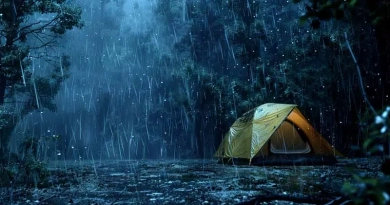
What Should I Do If There’s A Thunderstorm While Camping
When Lightning Strikes: Navigating Thunderstorms While Camping
There’s a peculiar thrill in watching the skies turn as we sit around a campfire, stories in tow. But when those skies darken with the threat of a thunderstorm, the air charged with electricity, a critical question arises: “What should I do if there’s a thunderstorm while camping?” As a camper, it’s essential to transform concern into action, blending caution with readiness to ensure safety in the wild embrace of nature.
Thunderstorms in the wilderness pose significant natural challenges that can swiftly alter the dynamics of a serene camping trip. Recognizing and respecting the sheer force of these storms is crucial for every camper to ensure safety. The primary dangers presented by thunderstorms—lightning, flash floods, and strong winds—each carry distinct risks, necessitating tailored strategies to manage them effectively.
Lightning
Because of its potential to strike with deadly force, lightning is an immediate and life-threatening hazard during thunderstorms. The risk of lightning strikes is particularly high in open areas or near isolated tall objects like trees, which can act as conductors. This risk is even greater on elevated terrain or near bodies of water, as water can enhance the conductivity of electrical charges. For campers, this means avoiding setting up camp under the tallest trees or on open hilltops where they might become the highest points.
Flash Floods
Flash floods represent another severe risk, especially prevalent in mountainous or low-lying areas. During thunderstorms, heavy rains can quickly transform placid streams and rivers into dangerous, fast-moving torrents. These can sweep away tents, gear, and even campers with little to no warning. The sudden nature of flash floods necessitates the need for preemptive measures, such as choosing campsite locations wisely—away from river beds and other flood-prone areas—and staying vigilant about weather conditions.
Strong Winds
Strong winds can abruptly escalate during a thunderstorm, capable of uprooting trees and converting unsecured items into hazardous projectiles. For campers, this means potential damage to tents and a risk of injury from flying debris. To mitigate these risks, securing all camping gear is essential. This includes staking tents firmly, securing loose items like chairs and cooking equipment, and avoiding camping beneath trees that could potentially fall.
Best Practices for Storm Safety
Navigating the threats posed by a thunderstorm while camping requires comprehensive preparation and swift, responsive action:
- Preparation Before the Storm:
- Check Weather Forecasts: Regular monitoring of weather forecasts before and during your trip is essential. Advanced warning provides crucial information that may necessitate postponing or rerouting your plans.
- Campsite Selection: Choose a campsite that minimizes potential dangers. This includes avoiding flood-prone areas or camping under isolated, tall trees. Opt for sheltered locations, but avoid areas like shallow caves or depressions where electrical currents can be focused if lightning strikes.
- At the First Sign of a Storm:
- Seek Shelter: The safest place during a thunderstorm is inside a vehicle, which can act as a Faraday cage, safely conducting electrical charges to the ground. If a vehicle isn’t available, find lower ground away from tall structures or trees, but steer clear of ditches and depressions where water could gather.
- Reduce Contact with the Ground: If you find yourself outside, try to minimize your contact with the ground by crouching down on the balls of your feet to lessen the chance that a ground current from a nearby lightning strike will affect you.
- Secure Loose Items: Secure or store any loose items to prevent them from being blown away or becoming dangerous projectiles during strong winds.
- During the Storm:
- Stay Inside Your Shelter: Whether in a tent or a vehicle, remain inside until the storm passes. Avoid contact with any metal parts or the sides of the tent.
- Avoid Water: Stay clear of lakes, rivers, and other bodies of water, as they are excellent conductors of electricity.
- Post-Storm Protocol:
- Assess the Area for Damage: Once the storm has passed, carefully check your campsite and surrounding area for new hazards such as fallen branches or signs of erosion.
- Stay Informed: Continue to monitor weather updates through a portable radio or smartphone, ensuring you’re prepared for any additional incoming storms.
By adhering to these practices, campers can effectively mitigate the risks associated with thunderstorms. Preparation, informed decision-making, and appropriate response actions are key to ensuring safety and preserving the joy and serenity of the camping experience, even when nature reveals its tumultuous side.
Necessary Resources and Tools
To effectively implement these safety measures, ensure you have the following:
- Weather-Resistant Gear: Sturdy tent, tarps, and waterproof clothing.
- Communication Devices: Smartphone and portable radio for weather updates.
- Safety Equipment: First aid kit, flashlights, and extra batteries.
- Secure Storage: Use waterproof bags or containers to protect gear from rain and floods.
The Calm After the Storm
As the thunder faded and peace descended once again over the campsite, the storm’s passing reminded us of nature’s dual nature—its capacity to awe and its power to challenge. By respecting its might and preparing accordingly, campers can ensure that when thunder rolls, they remain not just observers but survivors, adept at finding the safe harbor even under the most turbulent skies. With the right knowledge and tools, the question of what to do if there’s a thunderstorm while camping becomes not a panic, but a plan, transforming fear into respect and danger into precaution.






